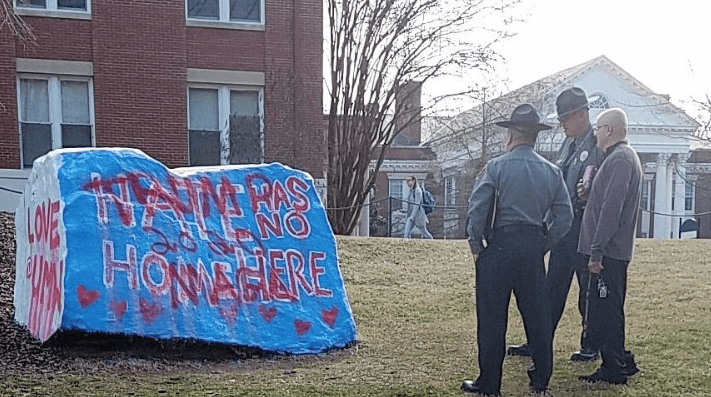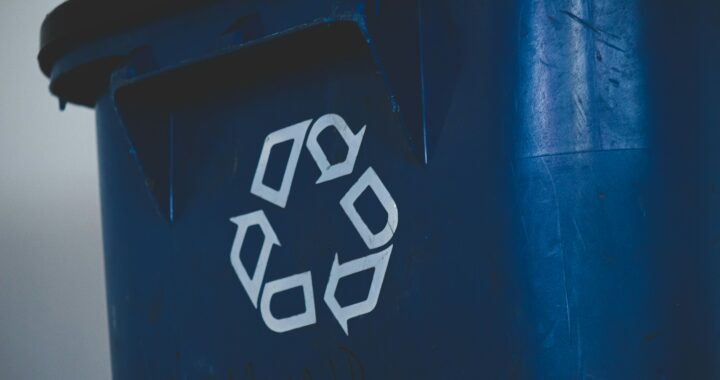The rules of the spirit rock
6 min read
Daniel Arango | Twitter
By GINNY BIXBY
Viewpoints Editor
When Natalie Johns, president of the UMW Firearms Club, painted the spirit rock with some other members on Feb. 14, she had no idea that the message she painted would cause such an uproar among students.
The junior, with her club, had organized a concealed carry and personal safety class to be held that Friday, and she wanted to use the rock to advertise it to students and faculty. But a few hours after members of the club painted it, the news of the mass shooting at Marjory Stoneman Douglas High School in Parkland, Florida, broke
The nature of the advertisement involving firearms juxtaposed against the mass shooting stirred up controversy among students, especially on social media, with suggestions that the advertisement was distasteful. In less than 24 hours, the rock had been painted over with the message “18 school shootings in 2018”, and the name of the Firearms Club had been crossed out with black paint. It is still unknown who did this.
But Johns said the timing was all a coincidence, and that she and her club had taken special consideration to follow the rules of the rock as listed in the UMW Student Handbook. The handbook states, “Absolutely no profanity or vulgarity is permitted. The Student Code of Conduct applies to the Spirit Rock. Only latex paint is permitted. Freshly painted messages should be allowed to remain in place for 24 hours before being repainted by another individual or group. The Spirit Rock belongs to students, who are ultimately responsible for it. If students dislike a message on the rock, it is their responsibility to repaint it. Questions regarding the Spirit Rock should be addressed to the SGA.”
“We planned to paint on Monday but it was raining,” Johns said. So the club rescheduled to paint on Tuesday. But then on Monday evening, UMW Theatre painted the rock with an advertisement for “Dead Man’s Cell Phone”, so the members made a decision to observe the 24 hour courtesy period and wait until Wednesday. “We started around 12:00 pm or 12:30 pm on Wednesday,” she said.
Over the week, the rock continued to be repainted, with College Republicans and Young Americans for Freedom painting a message in support of the victims of the shooting, and Young Democrats painting “Hate Has No Home Here” in response to stickers posted on campus by white supremacist group Patriot Front. But these messages were both vandalized with spray paint graffiti that read “MAGA Trump 2020” and led to a police investigation.
“I was definitely a bit upset because my club members and I spent a lot of time working on the rock and we were really excited to promote our [course],” said Johns. “All of us painting the rock had a lot of fun and it was a great club bonding experience. I think I can speak for the majority of the Firearms Club members that we were really surprised about the incident, especially since we were promoting a personal safety/gun safety class.”
Beyond the political controversy, these incidences brought about debate between students about what the rules for the rock even are, and if these rules should be more heavily policed.
“There’s really not much information available concerning the rock so nobody really knows the rules,” said senior Robyn Huffman.
“I’ve seen everything from a Happy Birthday message, a sports game or club event, to fraternities advertising themselves,” said senior Gloria Martin. “I have seen people cross out other people’s words or paint their fraternity symbol over someone else’s advertisement.” The topic of off-campus fraternities being able to paint the rock has also been controversial among students.
Dean of Student Life and Student Government Association (SGA) advisor Cedric Rucker said that the rock is regulated by SGA and is an entirely student-led effort that administration does not interfere with.
“The rock is for students,” said Rucker. “We have the statement of community values, and I would expect students to hold their behaviors in concert with the statement. The rock is a public forum. It’s not for me as an administrator to police what is written on the rock.”
Rucker said that there have been only been a few situations where students addressed concerns about the rock with SGA and administration, and that the majority of the usage of the rock has been positive.
Matt Good, SGA Director of Communications, said that while SGA is the contact point for questions regarding the rock, there are not specific guidelines set in place by SGA.
“The 24 hour waiting period is a courtesy rule,” said Good. “It is not enumerated as having consequences.”
Good said that because the handbook is clear that the rock belongs to the students rather than just clubs, SGA will not stop off-campus student groups such as unofficial fraternities and sororities from painting the rock. However, if an off-campus entity that is not UMW student-led paints the rock, that is considered vandalism.
Good confirmed that no clubs have precedence over other clubs in painting the rock, and clubs cannot reserve the rock. The University does, however, have the right to repaint the rock for University events such as open houses and Giving Day.
“We have toyed with the idea of creating a formal system of signing up to paint the rock, but we haven’t passed anything,” said Good.
In regards to the recent repainting controversies, Good said that the SGA does not want to police students’ right to free speech. “It speaks to the larger free speech [debate] in this country and determining what counts as free speech and what counts as hate speech. The line can be really blurred a lot of the time,” he said.
Another discrepancy over the rock is that in past years, the Office of Student Activities and Engagement (SAE) has provided paint for clubs to use to paint the rock. But this year, clubs have had to provide their own paint, and the reason why has not been made clear.
Junior and Finance Committee Chair Alyssa Ruhlen said that there is a lot of confusion about paint being provided, and that paint provisions are under the control of the Inter-Club Association (ICA).
“ICA is expected to come to Finance Committee and request funds to purchase paint that clubs are allowed to use to paint the rock,” said Ruhlen. “Clubs are never expected to purchase paint themselves, and are supposed to request paint from SAE. SAE has paint bins, brushes, and rollers that they can use as well. I’m not sure if SAE has paint currently, but I know that ICA has not come to Finance Committee this year to request funds for new paint.”
“I personally wish that paint would be provided,” said freshman Anna Beth Tanner. “I feel like there are clubs on campus that aren’t as well known, and don’t have as much money as other clubs, and I feel like that would really help make painting the rock more fair.”
In response to the possibility of some of the vandalism coming from outside the UMW community, Rucker said that there is no way to police such instances from occurring without limiting students’ freedom.
“I think students are good stewards of policing these things themselves,” Rucker said. “We are an open university and a public space.”
He encouraged students to continue to discuss issues of free speech and the rock and to bring their concerns to SGA.
“I think public discourse in all forms is important and beneficial, and I think that the students are empowered to act in ways which undergird who we are in terms of our collective community identity,” Rucker said.
“The spirit rock is to signify unity instead of division,” said sophomore Mckayla Washington. “The rock is the ‘flag’ of our school. And we all have to remember that each one of us matters even though we are all very different. The rock is there to remind us that unity is important.”











